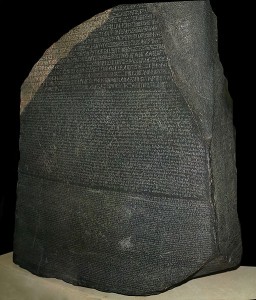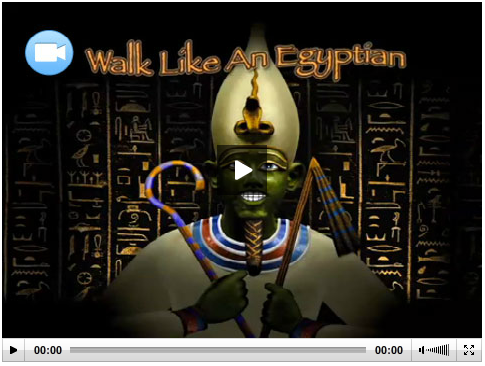
What is the Rosetta Stone?
A Lesson Plan About Ancient Egypt:
Students Create Their Own Rosetta Stone
For thousands of years after the end of the ancient Egyptian civilization, people appreciated how pretty hieroglyphics were, but couldn’t read them. All the information in the hieroglyphics was lost. This all changed in 1799, in a town called Rosetta, in Egypt, when archaeologists found the Rosetta stone. What is the Rosetta Stone? This smooth dark stone is almost four feet tall, and it has three different languages written on it. Because the same passage is written in Greek, demotic (another ancient language) and hieroglyphics, historians have been able to figure out the meaning of many hieroglyphic symbols. The stone effectively translated the language of ancient Egypt into words that historians could understand.
Lesson Plan For Students to Create Their Own Rosetta Stone
Objective: Students will understand why the Rosetta stone was a major breakthrough for the study of Ancient Egypt, and understand how it worked.
1. Play Flocabulary’s Ancient Egypt video, “Walk Like An Egyptian.” Ask students how you think modern people learned so much about Ancient Egypt? (Students might give answers like archeologists, stories passed down, hieroglyphics.) Tell your students that you’ll be focusing on one important way that people learned more about the ancient Egyptians: hieroglyphics.
2. Tell your students about the Rosetta stone and why it was important. (More information about it is at the top of this post.)

3. Explain to students that they will create their own Rosetta stones to transmit a secret message to a classmate. Students should write down their favorite quotation in English. Make sure that they don’t show it to anyone.
4. Students will then create their own symbols for each letter of the alphabet. Give students no more than 5-10 minutes to do this (or it could take quite a while…). Then have students write their favorite quotation using their new symbols.
5. Students will now create a Rosetta Stone. Have each student write down the following phrase in normal English, and then write the same phrase in their symbol language:
The quick brown fox jumps over the lazy dogs.
Students will then hand a partner their quote in code, as well as their “Rosetta stone” key. Their partners will translate the code. In the same way that Egyptologists learned more about Ancient Egypt through translating the Rosetta Stone, students will learn a little bit more about their partner because of their favorite quotation.
Possible extension: Have students research other codes that have been cracked that allowed people to learn more about others.
Liked the Ancient Egypt Video? See hundreds more Flocabulary songs and videos with a free trial to Flocabulary.

